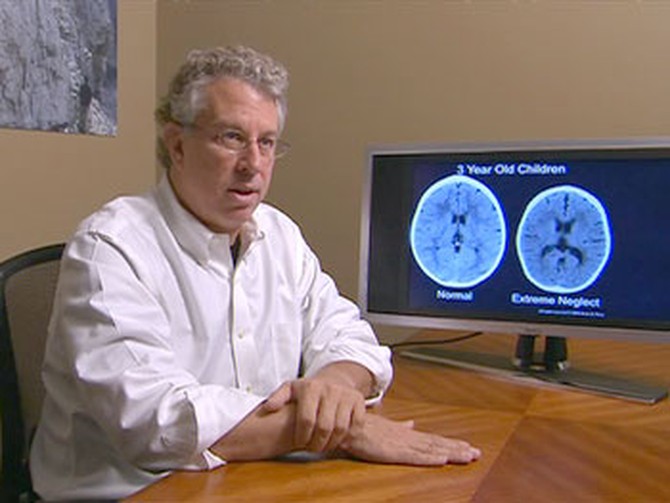The Effects of Child Neglect
Dr. Armstrong says she cannot assess if Danielle was born with the mental disabilities she has now. "We'll never know, because her mother never took her to a doctor from the time she was born," she says. "What we do know is extensive medical tests were run on her, including scans of her brain and genetics and other types of tests, and nothing was found—nothing that can account for the retardation that she has."
Dr. Perry was one of the first people to use MRI technology to look at the effects inadequate nurturing and touch or lack of touch can have on the brain of a small child.
Dr. Perry compares a brain scan of a normal, healthy 3-year-old child with a child who was severely neglected his first three years of life. "The first thing is that the brain is a little bit smaller. The brains of really severely neglected children tend to be smaller than the brains of children who have not been neglected," he says. "The brain didn't grow and shrink. It just didn't grow.
On the brain scan, Dr. Perry also notices dark spaces in the neglected child's brain. "Big, big ventricular spaces, which will impact sleep, regulation of anxiety, regulation of mood, whether or not you're very happy or sad," he says.
"As you grow, the brain is essentially like a sponge," Dr. Perry says. "It's absorbing all kinds of experiences. So if a child is not held, touched, talked to, interacted with, loved, literally neurons do not make those connections, and many of them actually will die."
Simple things like eye contact, touch, rocking and humming can make all the difference to a baby, Dr. Perry says. "It makes neurons grow, it makes them make connections," he says. "Then, it makes the brain more functional."
Dr. Perry was one of the first people to use MRI technology to look at the effects inadequate nurturing and touch or lack of touch can have on the brain of a small child.
Dr. Perry compares a brain scan of a normal, healthy 3-year-old child with a child who was severely neglected his first three years of life. "The first thing is that the brain is a little bit smaller. The brains of really severely neglected children tend to be smaller than the brains of children who have not been neglected," he says. "The brain didn't grow and shrink. It just didn't grow.
On the brain scan, Dr. Perry also notices dark spaces in the neglected child's brain. "Big, big ventricular spaces, which will impact sleep, regulation of anxiety, regulation of mood, whether or not you're very happy or sad," he says.
"As you grow, the brain is essentially like a sponge," Dr. Perry says. "It's absorbing all kinds of experiences. So if a child is not held, touched, talked to, interacted with, loved, literally neurons do not make those connections, and many of them actually will die."
Simple things like eye contact, touch, rocking and humming can make all the difference to a baby, Dr. Perry says. "It makes neurons grow, it makes them make connections," he says. "Then, it makes the brain more functional."
Published 03/03/2009


